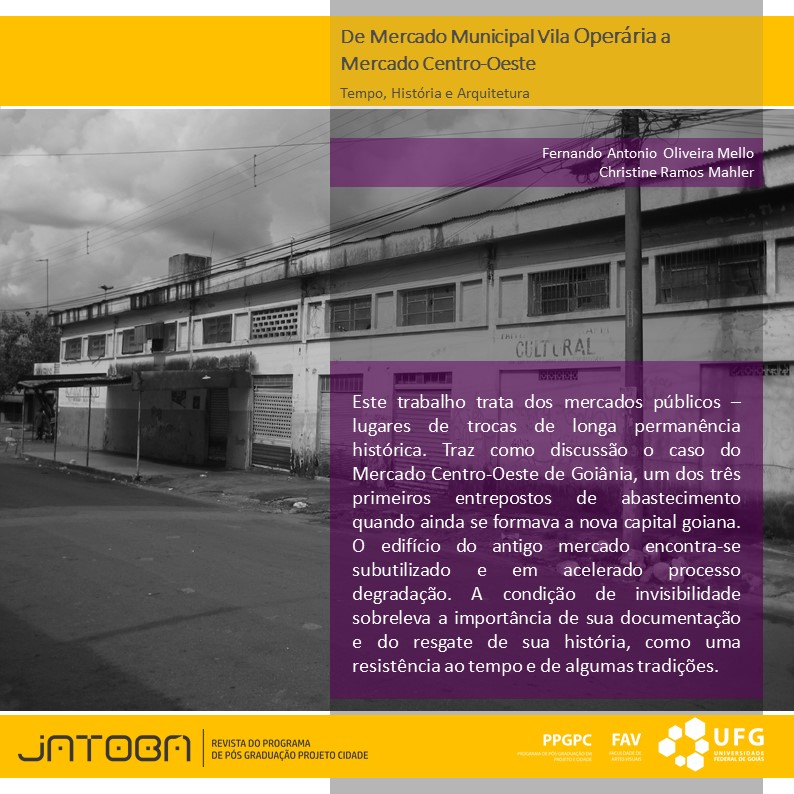De Mercado Municipal Vila Operária a Mercado Municipal Centro-Oeste
tempo, história e arquitetura
DOI:
https://doi.org/10.54686/revjat.v2i.65709Keywords:
Public Markets. Cultural Heritage. Vila Operária Market. Centro-Oeste Market. Goiânia.Abstract
: This paper deals with public markets – places of exchange of long historical term – in the field of theory, history and criticism of Architecture and Urbanism. It brings the discussion of the case of the Centro-Oeste Market, one of the three first supply warehouses when the new capital of Goiás was still being shaped. Although the fair and the market in the former Vila Operária had an important role linked to the supply and, above all, to the social relations they fostered in the region, the old market building is underused and goes through an accelerated degradation process. The condition of invisibility underscores the importance of its documentation and the recovery of its history. To achieve this aim, this paper was based on documentary research and in loco surveys, with a brief approach of the history of public markets with emphasis on the history of the formation of Goiânia, its popular neighborhoods, specially the Centro-Oeste district, previously called Vila Oparária. The Centro-Oeste Market, an important landmark of this neighborhood, is analysed in terms of its urban insertion and of the counterpoint of the original use and its present state. Thus, the documentation and morphology, both of the market and of the region it is placed in, have interest. As contributions, it is expected to give visibility to the neighborhood and to the market, to demonstrate its potential based on its original values and of the possible complementary uses that would integrate it in the dynamics of the contemporary city.
Key-Words: Public Markets. Cultural Heritage. Vila Operária Market. Centro-Oeste Market. Goiânia.
Downloads
References
BERNARDES, Genilda D’Arc. “O cotidiano dos trabalhadores da construção de Goiânia: O mundo do trabalho e extratrabalho”. Revista UFG. Goiânia: Editora UFG, v. 11, n. 6, p.37-51, jul. 2017. Disponível em: https://www.revistas.ufg.br/revistaufg/article/view/48230. Acesso em: 31 mar. 2019.
BORGES, Larissy Barbosa. Entre sons, aromas e sabores - As feiras em Goiânia: história, referência cultural e hibridação entre o moderno. Mestrado Profissional em Preservação do Patrimônio Cultural – Instituto do Patrimônio Histórico e Artístico Nacional, Rio de Janeiro, 2013.
BRAUDEL, Fernand. O jogo das trocas. Civilização material, economia e capitalismo: século XV-XVIII. São Paulo, Martins Fontes, 1996.
CHOAY, Françoise. A alegoria do patrimônio. São Paulo: Estação Liberdade; UNESP, 2006.
COSTA, Fernando Viana. Um ornitorrinco no cerrado: bairros populares e outros pioneiros na formação e expansão urbana de Goiânia. 2016. Mestrado em História Cultural – Programa de Pós-Graduação em História, Universidade Federal de Goiás, Goiânia, 2016.
COUTINHO, Evaldo. O espaço da arquitetura. São Paulo: Perspectiva, 1998.
FERRETTI, Sérgio. Reeducando o olhar: estudos sobre feiras e mercados. São Luís: Edições UFMA; PROIN(CS), 2000.
GOIÁS DE NORTE A SUL. História do Setor Centro-Oeste. 2016. Disponível em: https://goiasdenorteasul.com.br/programa_goiania--st-centro-oeste_51. Acesso em 10 abr. 2019.
JEUDY, Henri-Pierre. Reparar: uma nova ideologia cultural e política? In: JEUDY, H.P.; JACQUES, P. B. Corpos e cenários urbanos. Salvador: EDUFBA; PPG_AU/FAUFBA, 2006. pp. 13-23.
LIMA, Karla Kellen et al. A construção e a evolução da CEASA-GO: A central de abastecimento do cerrado brasileiro. Revista Baru - Revista Brasileira de Assuntos Regionais e Urbanos, Goiânia, v. 1, n. 1, p. 3-20, dez. 2015. Disponível em: http://seer.pucgoias.edu.br/index.php/baru/article/view/4459. Acesso em: 21 out. 2020.
LOPES, Ricardo Ferreira; VASCONCELLOS, Lélia Mendes. Considerações sobre os mercados públicos: relação de sociabilidade e vitalidade urbana nas cidades. Anais do III CINCCI – III Colóquio Internacional sobre Comércio e Cidade: uma relação de origem. São Paulo, 2010.
MALARD, Maria Lúcia. Alguns problemas de projeto ou de ensino de arquitetura. Cinco textos sobre arquitetura. Belo Horizonte: Editora UFMG, 2005. pp. 79-114.
MUMFORD, Lewis. A cidade na história: suas origens, transformações e perspectivas. São Paulo. Martins Fontes, 1982.
MURILHA, Douglas; SALGADO, Ivone. A arquitetura dos mercados públicos. Tipos, modelos e referências projetuais. Arquitextos, São Paulo, ano 12, n. 138.02, Vitruvius, nov. 2011 <https://www.vitruvius.com.br/revistas/read/arquitextos/12.138/4113>.
PINTAUDI, Silvana Maria. “Os mercados públicos: metamorfoses de um espaço na história urbana”. Scripta Nova: Revista Electrónica de Geografía y Ciencias Sociales, Barcelona: Universidad de Barcelona, v. 10, n. 218, ago. 2006. Disponível em: http://www.ub.es/geocrit/sn/sn-218-81.htm. Acesso em: 31 mar. 2019.
REBELLO. A.X. Revitalização do Mercado Central de Goiânia: Projeto de Gestão. Mestrado em Gestão do Patrimônio Cultural. Instituto Goiano de Antropologia e Arqueologia. IGPA-PUC, Goiânia, 2006.
ROSSI, Aldo. Arquitetura da Cidade. 2ª ed. São Paulo: Martins Fontes, 2001 (1a ed. 1966).
SANT‘ANNA, Márcia. “Patrimônio material e imaterial: dimensões de uma mesma ideia”. In: GOMES, M. A. A. F; CORRÊA, E. L. Reconceituações contemporâneas do patrimônio. Salvador: EDUFBA, 2011, p. 193-198.
SERVILHA, Mateus de Moraes; DOULA, Sheila Maria. “O mercado como um lugar social: as contribuições de Braudel e Geertz para o estudo socioespacial de mercados municipais e feiras”. Revista Faz Ciência. Francisco Beltrão: Unioeste, v.11, n.13 Jan./Jun. 2009, pp. 123-142. Disponível em: http://e-revista.unioeste.br/index.php/fazciencia/article/download/7610/5602. Acesso em: 14 mar. 2019.
SMITH, Adam. A riqueza das nações: investigação sobre sua natureza e suas causas. São Paulo: Nova Cultura, 1996.
VARGAS, Heliana Comin. Espaço terciário: o lugar, a arquitetura e a imagem do comércio. São Paulo: Ed. SENAC, 2001.

Downloads
Published
How to Cite
Issue
Section
License
- Autores mantém os direitos autorais e concedem à revista o direito de primeira publicação, com o trabalho simultaneamente licenciado sob a Licença Creative Commons Attribution 4.0 que permite o compartilhamento do trabalho com reconhecimento da autoria e publicação inicial nesta revista.
- Autores têm autorização para assumir contratos adicionais separadamente, para distribuição não-exclusiva da versão do trabalho publicada nesta revista (ex.: publicar em repositório institucional ou como capítulo de livro), com reconhecimento de autoria e publicação inicial nesta revista.
- Autores têm permissão para publicar e distribuir seu trabalho online (ex.: em repositórios institucionais ou na sua página pessoal) após a publicação inicial nesta revista, já que isso pode gerar alterações produtivas, bem como aumentar o impacto e a citação do trabalho publicado (Veja O Efeito do Acesso Livre).
- Foram feitos todos os esforços para identificar e creditar os detentores de direitos sobre as imagens publicadas. Se tem direitos sobre alguma destas imagens e não foi corretamente identificado, por favor, entre em contato com a revista Jatobá e publicaremos a correção num dos próximos números.














